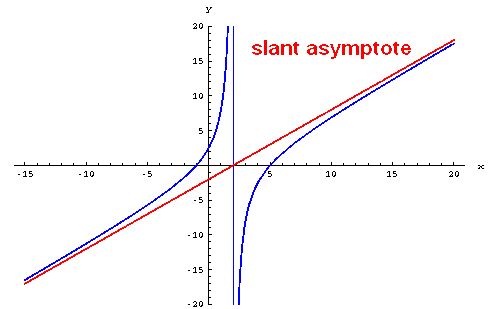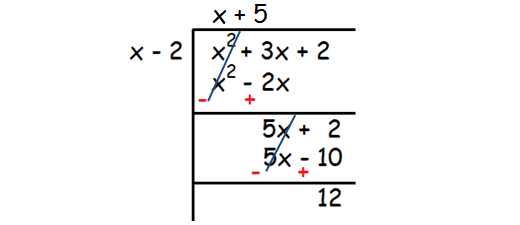how to find oblique asymptotes
HOW TO FIND SLANT ASYMPTOTE OF A FUNCTION
We will be able to find slant or oblique asymptote of a function, only if it is a rational function.
That is, the function has to be in the form of
f(x) = g(x) / h(x)
Rational Function - Example :


Finding Slant or Oblique Asymptote of a Rational Function
Let f(x) be the given rational function. Compare the largest exponent of the numerator and denominator.
Case 1 :
If the largest exponents of the numerator and denominator are equal, or if thelargest exponent of the numerator is less than the largest exponent of the denominator, there is no slant asymptote.
Case 2 :
If thelargest exponent of the numerator is greater than the largest exponent of the denominator by one, there is a slant asymptote.
To find slant asymptote, we have to use long division to divide the numerator by denominator.
When we divide so, let the quotient be (ax + b).
Then, the equation of the slant asymptote is
y = ax + b
Examples
Example 1 :
Find the slant or oblique asymptote of the graph of
f(x) = 1 / (x + 6)
Solution :
Step 1 :
In the given rational function, thelargest exponent of the numerator is 0 and the largest exponent of the denominator is 1.
Step 2 :
Clearly, thelargest exponent of the numerator is less than the largest exponent of the denominator.
So, there is no slant asymptote.
Example 2 :
Find the slant or oblique asymptote of the graph of
f(x) = (x2 + 2x - 3) / (x2 - 5x + 6)
Solution :
Step 1 :
In the given rational function, thelargest exponent of the numerator is 2 and the largest exponent of the denominator is 2.
Step 2 :
Clearly, thelargest exponents of the numerator and the denominator are equal.
So, there is no slant asymptote.
Example 3 :
Find the slant or oblique asymptote of the graph of
f(x) = (x2 + 3x + 2) / (x - 2)
Solution :
Step 1 :
In the given rational function, thelargest exponent of the numerator is 2 and the largest exponent of the denominator is 1.
Step 2 :
Clearly, thelargest exponent of the numerator is greater than the largest exponent of the denominator by one. So, there is a slant asymptote.
Step 3 :
To get the equation of the slant asymptote, we have to divide the numerator by the denominator using long division as given below.

Step 3 :
In the above long division, the quotient is (x + 5).
So, the equation of the slant asymptote is
y = x + 5

Apart from the stuff given above , if you need any other stuff in math, please use our google custom search here.
If you have any feedback about our math content, please mail us :
v4formath@gmail.com
We always appreciate your feedback.
You can also visit the following web pages on different stuff in math.
WORD PROBLEMS
HCF and LCM word problems
Word problems on simple equations
Word problems on linear equations
Word problems on quadratic equations
Algebra word problems
Word problems on trains
Area and perimeter word problems
Word problems on direct variation and inverse variation
Word problems on unit price
Word problems on unit rate
Word problems on comparing rates
Converting customary units word problems
Converting metric units word problems
Word problems on simple interest
Word problems on compound interest
Word problems on types of angles
Complementary and supplementary angles word problems
Double facts word problems
Trigonometry word problems
Percentage word problems
Profit and loss word problems
Markup and markdown word problems
Decimal word problems
Word problems on fractions
Word problems on mixed fractrions
One step equation word problems
Linear inequalities word problems
Ratio and proportion word problems
Time and work word problems
Word problems on sets and venn diagrams
Word problems on ages
Pythagorean theorem word problems
Percent of a number word problems
Word problems on constant speed
Word problems on average speed
Word problems on sum of the angles of a triangle is 180 degree
OTHER TOPICS
Profit and loss shortcuts
Percentage shortcuts
Times table shortcuts
Time, speed and distance shortcuts
Ratio and proportion shortcuts
Domain and range of rational functions
Domain and range of rational functions with holes
Graphing rational functions
Graphing rational functions with holes
Converting repeating decimals in to fractions
Decimal representation of rational numbers
Finding square root using long division
L.C.M method to solve time and work problems
Translating the word problems in to algebraic expressions
Remainder when 2 power 256 is divided by 17
Remainder when 17 power 23 is divided by 16
Sum of all three digit numbers divisible by 6
Sum of all three digit numbers divisible by 7
Sum of all three digit numbers divisible by 8
Sum of all three digit numbers formed using 1, 3, 4
Sum of all three four digit numbers formed with non zero digits
Sum of all three four digit numbers formed using 0, 1, 2, 3
Sum of all three four digit numbers formed using 1, 2, 5, 6
how to find oblique asymptotes
Source: https://www.onlinemath4all.com/how-to-find-slant-asymptote-of-a-function.html
Posted by: yamadacouren.blogspot.com

0 Response to "how to find oblique asymptotes"
Post a Comment